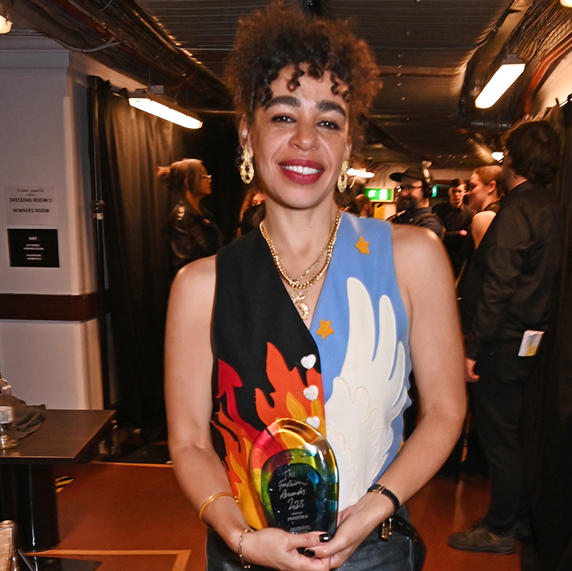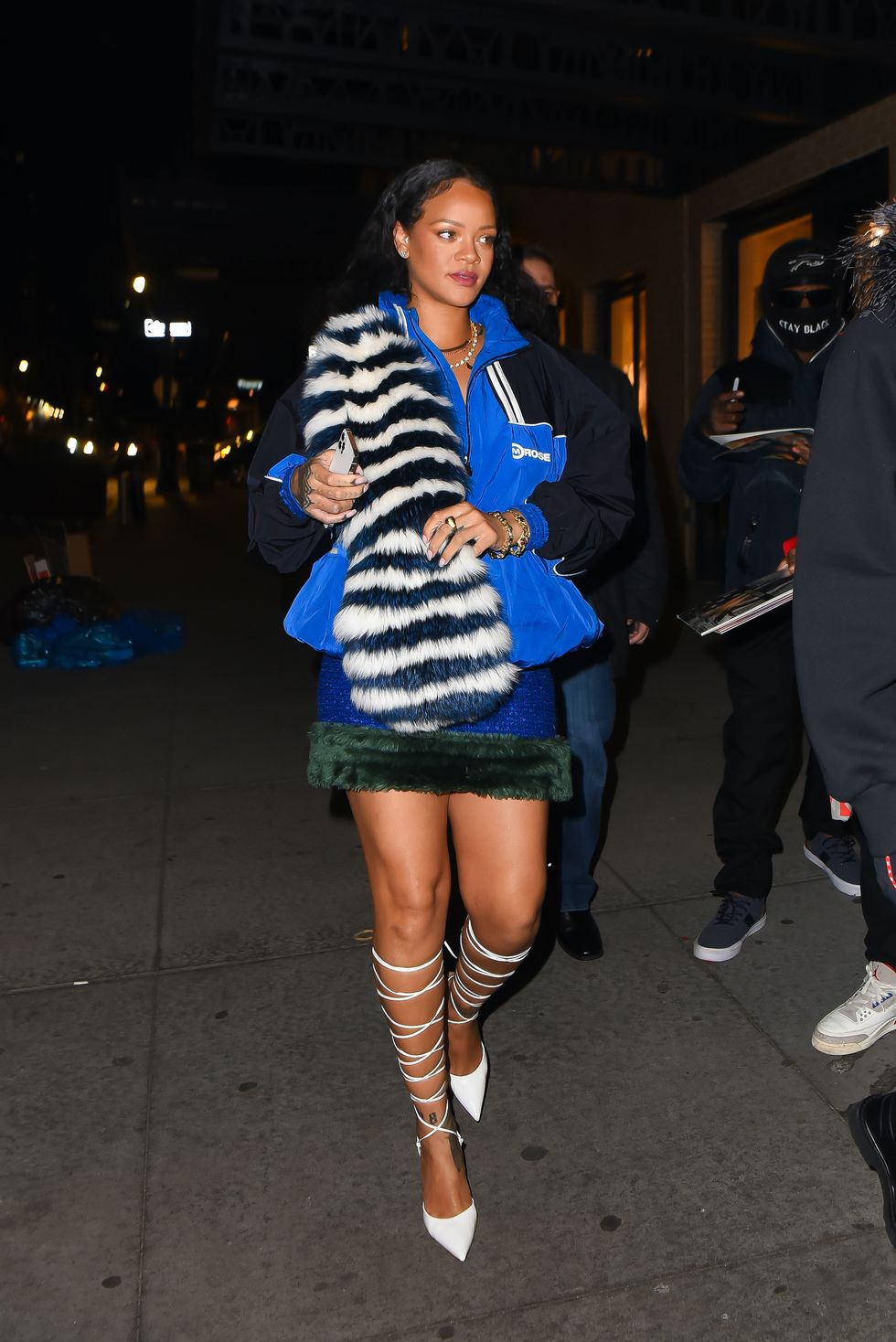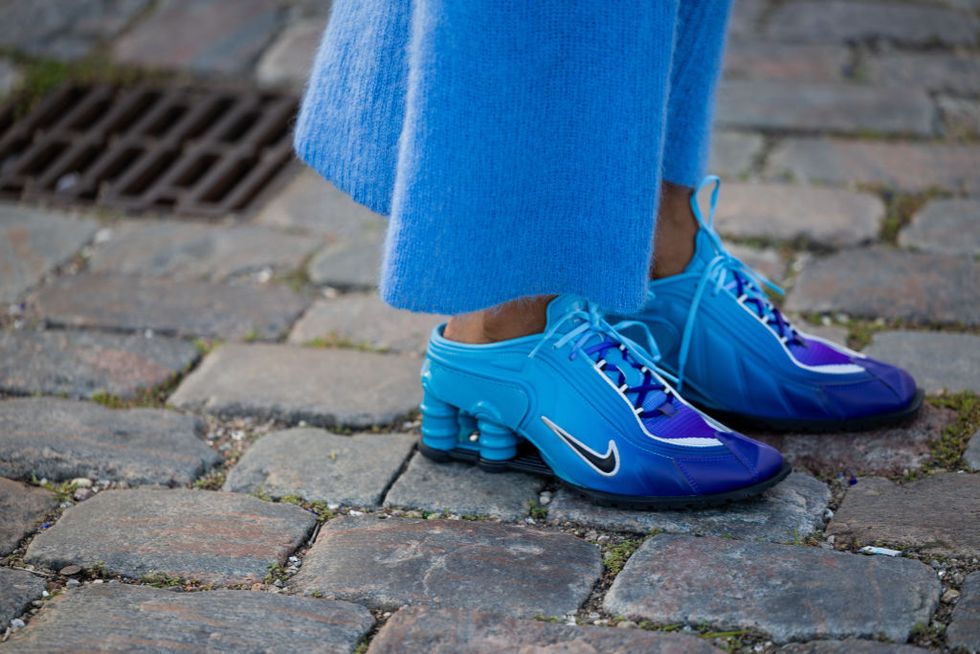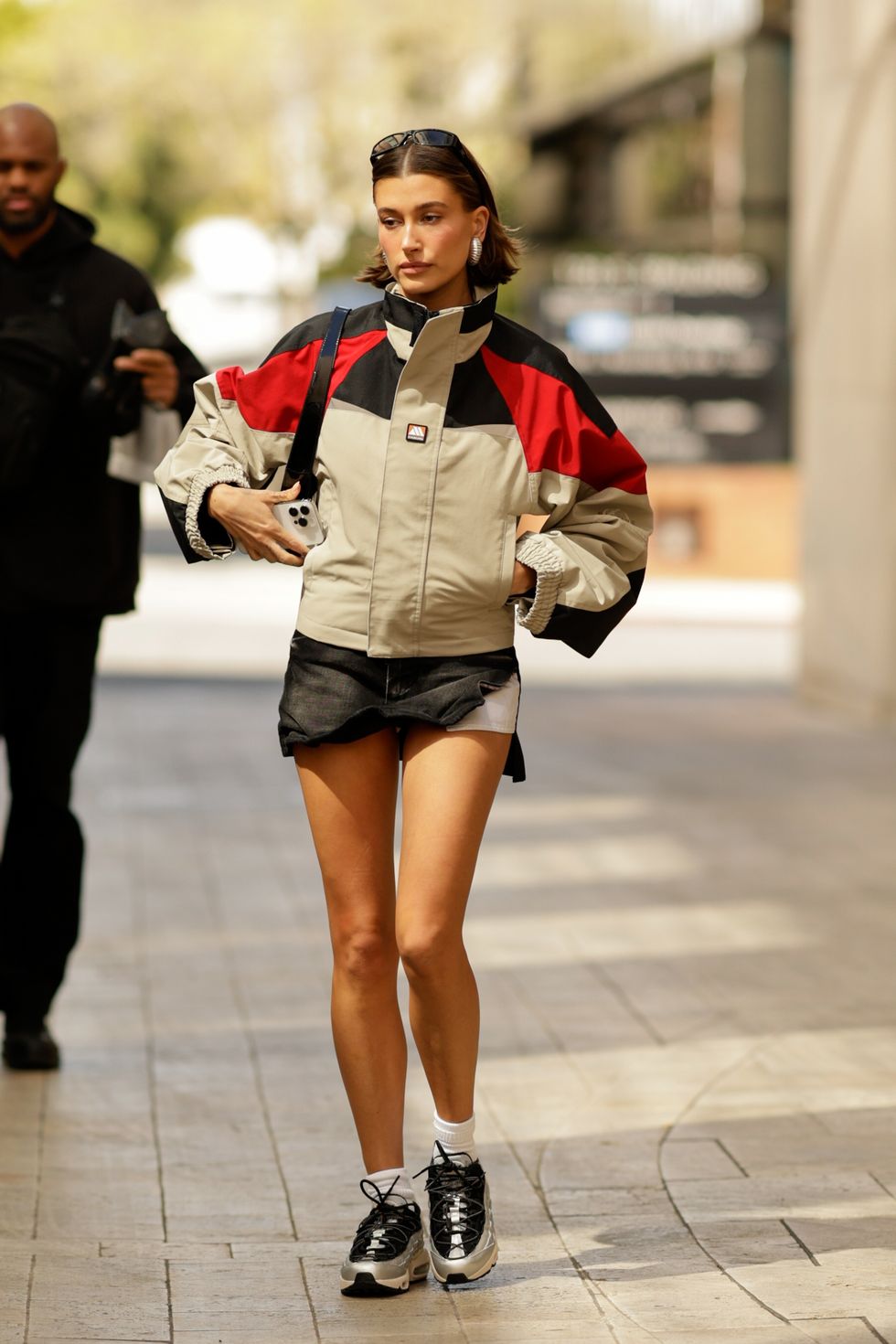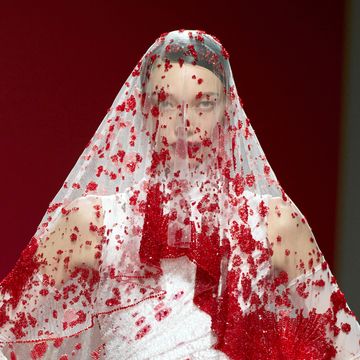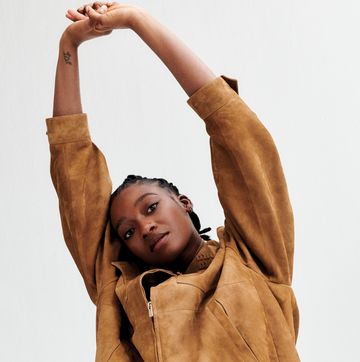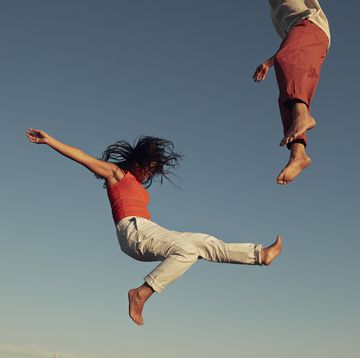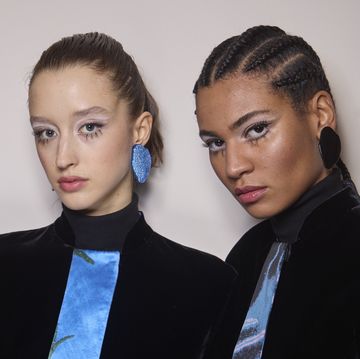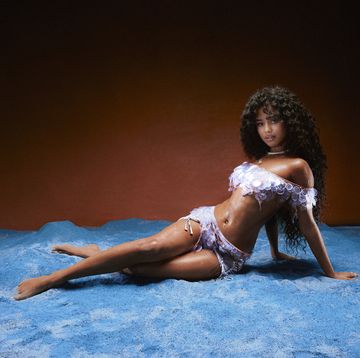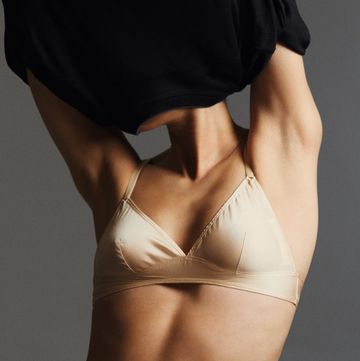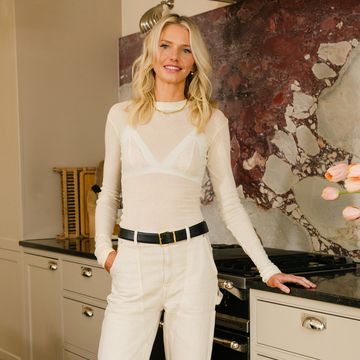A conversation with Martine Rose ranges far and wide. Mine, which takes place on a sunny autumn morning, covers everything from her most recent collection to designing for women, rave culture, rap lyrics and the outfit her older sister wore to Notting Hill Carnival in the Nineties.
I have interviewed Rose on several occasions, and this is my second time in her studio in London’s Crouch Hill. The atmosphere is always warm, and jam-packed with culture. An Alice Neel print is propped up by the window; a George Michael poster hangs in the loo. A book on Casa Susanna, the Sixties summer camp for cross-dressing men and transgender women, is in an organiser on Rose’s desk, under a copy of Jonathan Franzen’s Freedom.
I find her sitting on a bench outside, on a morning cigarette break. In a stylish rust-coloured Rejina Pyo cardigan and camo trousers, she greets me with her trademark grin and a hug. ‘Would you like a cup of tea?’ she asks. So far, so Martine – she might be one of the fashion world’s biggest stars, but she remains resolutely down-to-earth.
Rose’s 2023 was chock-a-block with moments that underlined her star power. She scored the prestigious spot as guest designer at men’s fashion week Pitti Uomo, showing her collection in Florence in January. In the run-up to the appointment of Pharrell Williams as creative director of menswear at Louis Vuitton in February, Rose was widely tipped to take the job. In July, she released a heeled version of Nike Shox, a shoe so sought-after it was deemed the fourth hottest product between July and September by fashion search engine Lyst. In August, she launched a campaign for her latest Nike collab and broke a certain corner of the internet by casting Leah Williamson and Nineties TV legend Ruby Wax. And, in September, she won an ELLE Style Award. Meanwhile, Rihanna, Bella Hadid, Kendrick Lamar and Hailey Bieber all wear her designs. Those aforementioned rap lyrics? That’s Lamar namechecking Rose during his verse on the song ‘The Hillbillies’. ‘He rhymes me with "sardine”,’ she says, laughing, always one to downplay associations with megastars. (This connection is deepening: in November, Rose launched a capsule collection of merch with Lamar.)
The designer, who started her label in 2007, is known for creations that take in diverse and esoteric influences. Although ostensibly menswear, her customer base has always been split 50/50 across genders. Cult pieces range from football shirts for imaginary teams, twisted to become a conceptual take on sportswear, oversized and purposefully wonky blazers and those wonderfully weird Nike Shox. ‘It’s always a shock when something that is quite out there is a commercial success,’ she says, with a giggle. ‘I never really see it coming. I don’t design with that commercial thing in mind. It’s just what I think is cool.’
Shows can cover everything from rock- climbing culture (SS18) to obscure Italian sports (AW23), beer mats (SS21) and even Brexit (SS20). Most recently – for SS24 – the humble community centre was in focus. The show took place in St Joseph’s Parish Centre in north London, with her signature street-cast models wearing everything from corsets to boxer shorts and fluffy mini dresses in a collection that was sexy, fun and packed full of desirable pieces. It’s the latest step on the unstoppable rise of Rose.
A few months on, how does she feel about the show? ‘I’m really proud of [it],’ she says, relaying an anecdote about how members of her team have bumped into models in the cast. ‘They said they felt that was such an amazing thing to be a part of: “with that money, I was able to buy a camera”, “I’ve never felt so sexy”, “I’ve never felt so seen”… Knowing that people have that sort of feeling and have taken it back into their lives, it’s really impactful.’ And the clothes? ‘I love how it looks, but [it’s] this other stuff that I’m really proud of.’
This ‘people first, fashion second’ approach is consistent with Rose’s world view – one always rooted in reality, putting a magnifying glass on the everyday. But, even with this central to the brand, it must be an ego boost when celebrities wear her clothes. ‘Of course!’ she says. ‘But I am just as delighted to see normal [people] wearing [my clothes]. Seeing people bring life to stuff, really wearing it out, that’s also a massive boost. That’s more important than [any famous person].’
Rose draws on her personal experience – she has staged shows at her daughter’s primary school and a local market where she used to buy her lunch. ‘There’s something about a primary school that feels a bit magic,’ she says. ‘The little chairs, the little toilets… it evokes a feeling of something in most people.’ Her daughter must have loved it, I say. ‘She was delighted, absolutely delighted,’ says Rose. ‘The teachers, too.’
While lots of designers work from a place of realism, perhaps the thing that makes Rose’s work so compelling is the way inspiration comes from reality – but it’s never quite as it seems. ‘It’s through a funhouse mirror,’ she says, with a minxy expression. ‘[The] things you recognise, seeing them again in a new way.’
Rose says this way of looking at things is partly why she likes menswear. ‘I think, probably, as a natural rule-breaker, it’s what attracted me,’ she says. ‘There are so many rules in menswear.’ Even with this focus, she is pleased women also wear her clothes. ‘I don’t know if it’s because I’m a woman designing menswear that women have felt somehow attached to it,’ she muses. ‘I don’t know if it’s got a particular female gaze that women can connect to, but women have always bought my clothes, so it’s great.’ The rise of her label has also coincided with a wider change in dress codes. ‘Women got off their towering heels and started wearing boys’ clothes and were being playful in a different way,’ she says.
Another phenomenon that has shifted fashion in the past 16 years is the rise of collaborations – something Rose has excelled at. After collabs with brands ranging from Stüssy to Tommy Hilfiger and Nike, she is guest creative director at Clarks this season. The result has that typical Rose heat. Previewed at her show in June, the collection of hiking sandals, Derbys, desert boots and high-heeled loafers will hit stores in February. With her trademark esoteric feel – a Derby comes with a seam across the toe, wrinkling the leather; a loafer has a bulbous heel – they will no doubt, like Shox, sell out.
Rose was born in 1980, and grew up in Croydon, the daughter of a nurse and an accountant, and the youngest of three siblings. If she is now a designer in demand, she is open and honest about struggling at the start of her fashion career. ‘I was ambivalent [about fashion]. I always had one foot in, one foot out,’ she says. ‘I was working in pubs and clubs – I really loved that – and I was doing this on the side.’
She kept going, she says, because, ‘I always had enough interest from just enough people of influence’. Kim Jones, the creative director of Fendi and Dior Men’s, was one of these people, as was fashion PR legend Mandi Lennard. ‘I remember Mandi saying to me once, when I was really down on my luck, “Don’t worry, the right people are watching,” and that really lifted me,’ says Rose. ‘And other various people in my career path have given me that nice little squeeze, you know, to carry on.’
The most life-changing of these came in 2015, when Demna – the creative director of Balenciaga – asked Rose to consult on the brand’s menswear, a role she maintained for three years. ‘It was like, “OK, maybe I can actually take this seriously and commit to it now.”’
She credits her parents, too, with their unwavering support. ‘I just feel really lucky,’ she says, a note of emotion coming into her voice. ‘Even when I was like, What the f*ck am I doing? This is a very expensive hobby, you should put it behind you and do something else. They were always 150% behind me. They come to every [show.]’
Rose began thinking about fashion as a career while studying for her art foundation as a teenager. ‘It’s just a method, I thought, suited with my taste, that I could use to tell a story.’
Studying fashion at Middlesex University, she graduated in 2002, an era that contrasts to our current one when it comes to prospects for aspiring designers. ‘I came out with about £30k in debt, which is significant, but not as crazy as what the students are coming out with now,’ she says (it’s estimated that in 2023, a student graduating from a BA would have around £45k in student-loan debt alone). Rose is passionate about how this restricts creative people. ‘It’s a massive loss to the arts, and how many people [there are who] would be the geniuses of tomorrow, who can’t even get access to that education,’ she says, telling a story of an artist friend of hers, who is from the generation that received financial support. ‘They could really focus on their practice, and that benefits all of us.’
Always an optimist, Rose suggests that the next generation of designers will ‘find another way’. She points to Fantastic Toiles, the pop-up shop established by her friend Nasir Mazhar, that stocks the work of emerging brands.
Something like Mazhar’s store recalls the scene when Rose took her first steps into fashion. ‘It was very creative and weird,’ she says. ‘It had weird people, which attracted me.’ Out of college, Rose was working as an intern at Arena magazine, and launched T-shirt brand LMNOP with her friend and stylist Tamara Rothstein. ‘[Interning] wasn’t massively creative so we set it up as a side project to be playful.’ However, when they scored stockists, it was a different ballgame. ‘We didn’t know what we were doing,’ she says, laughing. ‘Middlesex was amazing, but it taught me nothing about business or production or anything.’ After two years, the duo went in separate directions, though they still work together sometimes. Rothstein styled the community centre show in June.
Rose’s background influenced her views of design. ‘I was very, very interested in clothes, but the term fashion didn’t feature at all,’ she explains. ‘Catwalks and labels had no place in my life and what I was seeing. But I was interested in how people used clothes to express themselves.’
There was no shortage of formative references to pore over. ‘I grew up in a Jamaican household and style is way above fashion,’ she says. ‘It’s about how you put outfits together, how you’re flexing it. Clothes are a form of expression.’
Two memories bubble up when talking about early sartorial influences. ‘My sister really pushed the boundaries in terms of what she wore,’ recalls the designer. ‘She was wearing Pam Hogg; she was wearing Helen Storey. I remember my dad nearly had a stroke because of her outfit to Carnival. She made this skirt from one piece of chamois leather – it was obscene – with a tiny little bra top.’
Another early influence was a local tailor. ‘We had this amazing family dressmaker, Phyllis,’ she remembers. ‘She could just take your measurements and free cut. She had lived in a tiny flat in Wimbledon covered in fabric.’
As Rose grew up, a different influence took hold – that of nightlife. Her shows often have a party atmosphere and she is schooled in rave and club culture (in one of my first conversations with her, we discussed legendary Paradise Garage DJ Larry Levan, hardly the usual topic for a fashion designer). She also embodies it. After those years working in pubs and clubs, the designer has the energy of someone you become fast friends with while on the dancefloor.
She says she became aware of this world at around the age of nine, when she saw impromptu parties on Clapham Common. ‘That was probably the first sense of something, of music and people coming together, outside of my own family.’
She was hooked. ‘I had my 14th birthday at Strawberry Sundays, which was in Vauxhall,’ she says. ‘It was really wild. My nan had lots of parties but [they were] very much West Indian parties, in the house. This was people I’d never seen before, with all types of dressing in crazy ways. I loved that mix of people, that mix of ages.’
If nightlife culture was formative for Rose – and still underpins her designs – her life is somewhat different now, encompassing a thriving business and family life, with her partner, eight-year-old daughter and five-year-old son. She has learnt to be ruthless with her time. ‘I didn’t have children not to have a family,’ she says. ‘So I just have to be really concise with what I fit into my day. And then when I’m at home I’m 100% at home, I’m with them. And that’s it.’ What does she do for fun? ‘I went to a wedding in Sicily and we had the best time. I did not get off the dancefloor… but really it’s this work. There are shit bits, exhausting bits, boring bits. But what I do is really fun.’
